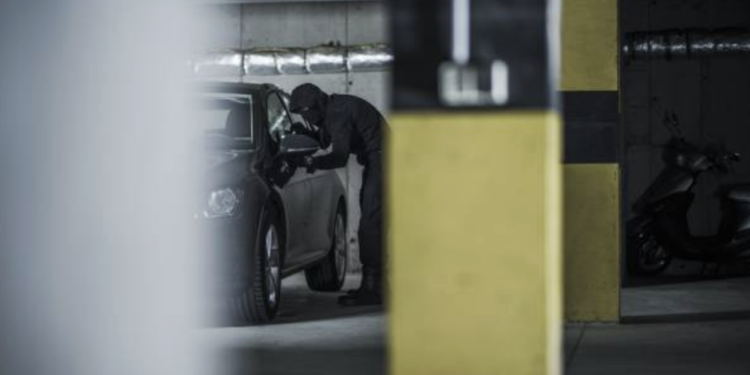Stolen vehicles are a dangerous crime, affecting people and communities all over the nation. On a daily basis, we hear about the heartache that these stolen vehicles have caused. In the U.S., vehicle theft is not only an ongoing concern for vehicle owners, but a headache for police departments across the country.
The National Insurance Crime Bureau recorded more than 800,000 last year. It’s a starkening trend. This has a direct impact on insurance rates and personal safety, which you can read all about here. By knowing the causes behind vehicle theft, police departments and car owners alike can work to prevent it.
Now more than ever, it’s important to find ways to protect your vehicles and enjoy the peace of mind that comes with it. From using state-of-the-art anti-theft devices to practicing smart safety measures, there are everyday actions we can all take. Stay educated and vigilant to keep your vehicle safe from thieves.
In 2023, a motor vehicle was stolen in the United States every 31 seconds. This startling statistic underscores the alarming prevalence of auto theft. More than 1 million vehicles were stolen that year, a 25% increase from the prior years.
This alarming trend serves as a reminder to stay up-to-date on vehicle security. Some makes and models are stolen at disproportionately higher rates, which should inform your purchase decision. Understanding which vehicles are most at risk could improve your odds of selecting a vehicle that’s less attractive to thieves.
GPS tracking technology has really changed the game in being able to quickly recover stolen vehicles. Such systems have been shown to be highly effective in finding and returning stolen cars quickly.
For example, a government-funded car with a GPS car tracker would be easily located in real time. This increases the likelihood of a rapid recovery tremendously. Whether you have an EV or a traditional ICE vehicle, this sort of technology provides peace of mind and is a smart investment for any vehicle owner.
The financial burden of vehicle theft is heavy, costing more than $8 billion a year. As a crime, it raises the insurance rate for everyone and unfairly penalizes honest owners monetarily.
In just Virginia, more than 10,500 vehicles are stolen annually with losses exceeding $120 million.
What to do if your car is stolenMake moves right away to recover your vehicle. Call the cops immediately!
For example, if you see something illegal like a chop shop operation, report it. The Help Eliminate Auto Theft (HEAT) program wants to assist you.
Once your vehicle has been confirmed stolen, contact your local police immediately to create a stolen vehicle report. This step will be important for initiating an insurance claim. Take action as soon as possible to maximize the potential for recovery!
Keep in mind, 35% of vehicles are located the same day and 45% within two days. Include as many specific details as you can, like vehicle make and model, color, and any distinguishing features. This assists law enforcement during their investigation, making it easier to trace a vehicle.
If it’s not a true emergency, don’t call 911—use your local non-emergency police number to help emergency responders focus on true threats.
Be sure to keep a copy of the police report for your personal records and for your insurance company. Having this document on hand will make it much easier when you message your insurance provider in less than 24 hours to set up a claim.
If you financed your car, do you have to tell your finance company that it was stolen? Or will your insurance provider handle that for you? Providing full cooperation with their investigation will go a long way toward making the process a smooth one.
In many regions, law enforcement will delay opening an investigation. It might be up to 10 days after they get the postal receipt. Keeping in mind that thieves can have stripped a vehicle in under 30 minutes, time is of the utmost importance.
If your vehicle is towed to an impound lot, know what to expect! You’ll have to provide proof of ownership and/or pay a series of fees, which can amount to hundreds of dollars.
Prevent theft. Before leaving your car, take valuables with you or lock them in the trunk to decrease chances of loss.
Notifying your insurance company that your vehicle was stolen is an important first step to getting it back. By acting quickly, you can expedite the claims process and improve your chances of recovering your vehicle. Once you’ve been in touch with police and have written up a report, share this report number with your insurance company.
This last detail makes all the difference in creating the best possible claims experience. For example, GEICO won’t even begin processing claims without a police report. This will help you establish a clear paper trail and hold your insurance provider accountable.
This documentation will be extremely helpful if any disputes come up or if you ever need to refer back to previous discussions. Understanding your policy’s coverage limits for theft can help manage expectations during the claims process, allowing you to plan accordingly.
Steps for Notification
- Contact the police to file a report.
- Gather necessary information about the vehicle.
- Notify your insurance provider with the police report number.
- Document all communications for future reference.
Required information
Before you go to report the theft, gather all necessary documents including the vehicle’s Certificate of Title. Provide names and contact information for anyone who may need access to the vehicle. Write a comprehensive specification sheet, with notable features or changes clearly stated.
Detail any personal property taken from the vehicle, too.
Impact on insurance rates
Filing a claim for stolen vehicles can raise insurance costs. Getting in a lot of claims can land you in the higher-risk driver category. Install theft deterrent devices. A good way to save on insurance is by installing theft deterrent devices.
Reviewing your policy annually ensures adequate coverage against theft-related losses.
Coverage for theft
Confirm what kind of coverage your auto insurance policy has for theft events. Learn what’s covered under comprehensive vs. Liability theft coverage. Learn what your state’s laws are regarding insurance payouts after theft.
Just be sure you’re ready to prove the vehicle’s value to backstop your claim on that end.
Process for financed vehicles
Notify your finance or leasing company as soon as possible after notifying the police about the theft. Note that the finance company will likely have requirements for reporting theft. This egregious theft can impact your outstanding loan obligations and insurance claims.
Here are the steps to follow when dealing with financed vehicles:
- Contact the police and file a report.
- Notify the finance company about the theft.
- File a claim with your insurance provider.
- Keep records of all communications.
Reporting as a teenager
Engage teens to ensure they file a stolen vehicle report as quickly as possible. Parents, guardians, and other trusted adults should be fully engaged in this process. In fact, most insurance companies give discounts for young drivers after they complete safety courses.
Give advice to teen drivers on how to keep their cars safe from thieves.
When a vehicle is stolen, the clock is ticking and every second matters. Acting quickly is key to improving the odds of getting your vehicle back. With every second that ticks by, the gap between you and your stolen car increases, making it harder to track or recover. Swift action can do a world of good.
GPSWOX, the pioneer in vehicle tracking and recovery systems, has a 90% recovery rate for vehicles installed with their systems. This stunning statistic underscores just how dire the need is for a speedy response.
Quickly reporting is crucial to helping our law enforcement. The earlier they can be alerted, the sooner they can start the process of tracking down the thieves. Law enforcement needs real-time information to establish roadblocks, obtain surveillance video, and work with adjacent jurisdictions.
It’s like playing a game of chess, where each move matters. Clients based in Texas, California, and New York have all told us about their experiences. They wanted to show how DMV Central’s assistance allowed them to quickly recover their stolen vehicles.
Capturing every aspect of the theft will also be important when filing an insurance claim. Collecting basic information such as the time and location of the theft, when applicable the vehicle identification number, and any witness statements creates an easily understandable narrative for insurers.
This valuable information ensures a smoother claims process. These delays in reporting not only make recovery more challenging but prevent insurance companies and anyone else from adjusting claims. Quick action can sometimes even track down and recover a stolen vehicle within the first hour, avoiding big losses altogether.
Recovery and Aftermath
Once your vehicle has been recovered, it’s important to report this to the police as soon as possible. This initial step at least makes sure they’re able to amend their final determinations and take steps to find new evidence, potentially.
Second, get in touch with your insurance provider. They have to be aware of the fact that they can tailor your claim based on the recovery you’re able to secure. After recovering, knowing the state of your vehicle is important.
Check for visible damage or parts that may be missing. Documenting this information will not only help with your insurance claim, but will benefit the police as they begin to investigate the crime. If someone has vandalized or otherwise destroyed your car, we have you covered too. Our architecture and design practice based in our NoHo/Burbank studios would love to help you.
- Notify the police and insurance company immediately.
- Assess the condition of the vehicle.
- Document any damages for insurance claims.
- Arrange for repairs if necessary.
Being familiar with your insurance policy will allow you to better understand which repair costs you may have covered. Most policies include theft and vandalism damage repair, but it’s important to check your policy to be sure.
Once you’ve recovered your vehicle, obtain a vehicle history report. This brilliant trick exposes thieves trying to make off with your vehicle. Passing this information along to police can be incredibly helpful.
While your theft claim is being processed, a rental vehicle may be an immediate need. Many insurance policies will cover this expense, so be sure to check with your provider.
Plan for the length of your rental, expenses and insurance for the rental car. Availability and the kind of vehicle one would need to use personally is something to take into account.
Check out the GEICO Car Buying Service to save time and money if buying a replacement vehicle is in your future. Safety ratings and theft rates should help inform your decision, and you may be eligible for additional discounts from your insurer.
Taking these steps ensures a wise purchase:
- Research vehicle options that meet your needs.
- Compare prices and financing options.
- Utilize insurance resources for guidance.
- Finalize the purchase and update your insurance policy.
Preventing future theft is crucial. With any theft, the best prevention comes from a combination of security measures. Adding steering wheel locks and alarm systems to cars provide redundancies.
Parking in well-lit areas or in parking garages with security helps discourage thieves. Making sure valuables aren’t visible in parked cars is a simple but smart preventive step.
Additional strategies include:
- Install car tracking devices for real-time monitoring.
- Use anti-theft devices and alarms.
- Be mindful of where you park your vehicle.
- Regularly check and maintain vehicle security features.
Prevent Future Theft
Improving vehicle security isn’t just a good idea – it’s imperative. One effective method is using geofencing technology, which sets virtual boundaries and alerts you if your vehicle crosses them. Prevent future theft. Regular maintenance checks will help you make sure all security features—alarms, locks, etc—are in working order.
Being aware of rising theft trends in your area and specific locations where thieves are targeting vehicles helps you get a jump on keeping your car safe. Here are some strategies to consider:
- Additionally, these systems improve resilience by allowing for quicker recovery with real-time location tracking.
- Install security cameras in parking areas: Cameras act as a deterrent and provide evidence if theft occurs.
- By providing a safer community, these programs make residents more aware of their surroundings.
- Understanding vehicle safety practices can prevent carelessness that leads to theft.
Prevent it by taking the basic precautions of keeping your keys on you at all times, locking your doors, and parking in well-lit areas. Look into the new vehicle recovery systems to help law enforcement help you. Protect keys from relay attacks with metallic wraps or Faraday wallets.
GPS tracking devices are indispensable assets in preventing theft. They serve as a force multiplier, enabling law enforcement to quickly and efficiently recover stolen vehicles. Plus, they offer 24/7 tracking and real-time notifications if someone tries to move it unexpectedly.
Here are the benefits:
- GPS systems significantly improve the likelihood of vehicle recovery.
- You can check your vehicle’s location anytime.
- Receive real-time alerts if someone tampers with your fence.
- Insurance discounts: Installing a tracker might lower your premiums.
It’s critical to understand how theft affects insurance policies. Be sure to maximize your coverage with regular reviews, and store personal items out of view to discourage opportunistic thieves.
Keep up-to-date and easily accessible records of vehicle ownership and modifications.













